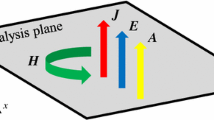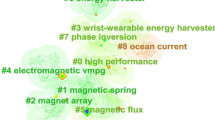Summary
The homogenization design method has been successfully applied to obtain the optimal topology of a structure under electrical fields as well as various mechanical environments. This paper introduces the expansion of the application of the homogenization design method into the structure in magnetic fields. The topology optimization on a device in magnetic fields is focused on the maximizing the magnetic flux in an air-gap. This is accomplished by maximizing the magnetic mean compliance defined by the magnetic energy in a given region of the device. The homogenization design method is applied to three-dimensional cases with and without considering the saturation effect of the material. Results show that the homogenization design method is valid to maximize the vector potential in linear cases and the magnetic flux in non-linear cases.
Similar content being viewed by others
References
Neittaanmaki, P.et al. (1996),Inverse Problems and Optimal Design in Electricity and Magnetism, Oxford University Press.
Sikora, R. and R. Polka (1982), “Synthesis of magnetic fields,”IEEE Transactions on Magnetics,18, No. 2, 385–390.
Marrocco, A. and O. Pironneau (1978), “Optimum design with Lagrangian finite elements; design of an electromagnet”,Comput. Methods Appl. Mech. Engrg.,15, 277–308.
Silvester, P.P. (1969), “Finite element solution of homogeneous waveguide problems”,Alta Frequenza,38, 313–317.
Nakata, T. and N. Takahashi (1983), “New design method of permanent magnets by using the finite element method”,IEEE Transactions on Magnetics,19, No. 6, 2494–2497.
Istfan, B. and S.J. Salon (1988), “Inverse nonlinear finite element problems with local and global constraints”,IEEE Transactions on Magnetics,24, No. 6, 2568–2572.
Li, Z., P.Y. Papalambros and J.L. Volakis (1997), “Designing broad-band patch antennas using the sequential quadratic programming method”,IEEE Transactions on Antennas and Propagation,45, No. 11, 1689–1692.
Lowther, D.A., W. Mai and D.N. Dick (1998), “Automated design of magnetic devices by optimizing material distribution,”IEEE Transactions on Magnetics,34, No. 5, 2885–2888.
Byun, J., S. Hahn and I. Park (1999), “Topology optimization of electrical devices using mutual material energy and sensitivity”,IEEE Transactions on Magnetics,35, No. 5, 3718–3720.
Bendsøe, M.P. and N. Kikuchi (1988), “Generating optimal topologies in structural design using a homogenization method”,Comput. Methods Appl. Mech. Engrg.,71, 197–224.
Suzuki, K. and N. Kikuchi (1991), “A homogenization method for shape and topology optimization”,Comput. Methods Appl. Mech. Engrg.,93, 291–318.
Diaz, A. and N. Kikuchi (1992), “Solution to shape and topology eigenvalue optimization problems using a homogenization method”,International Journal for Numerical Methods in Engineering,35, 1487–1502.
Yoo, J., N. Kikuchi and J.L. Volakis (2000), “Structural optimization in magnetic devices by the homogenization design method,”IEEE Transactions on Magnetics,36, No. 3, 574–580.
Sanchez-Palencia, E. (1980),Non-Homogeneous Media and Vibration Theory, Berlin: Springer, Berlin.
Tärnhuvud, T. and K. Reichert (1988), “Accuracy Problems and Torque Calculation in FE-Systems”,IEEE Transactions on Magnetics,24, No. 1, 443–446.
Salon, S.J. (1995),Finite element analysis of electrical machines, Kluwer Academic Publishers.
Salon, S.J. and B. Istfan (1986), “Inverse nonlinear finite element problems”,IEEE Transactions on Magnetics,22, No. 5, 817–818.
Istfan, B. and S.J. Salon (1988), “Inverse nonlinear finite element problems with local and global constraints”,IEEE Transactions on Magnetic,24, No. 6, 2568–2572.
Author information
Authors and Affiliations
Rights and permissions
About this article
Cite this article
Yoo, J., Kikuchi, N. & Volakis, J.L. Structural optimization in magnetic fields using the homogenization design method — Part I. Arch Computat Methods Eng 8, 387–406 (2001). https://doi.org/10.1007/BF02743738
Received:
Issue Date:
DOI: https://doi.org/10.1007/BF02743738




